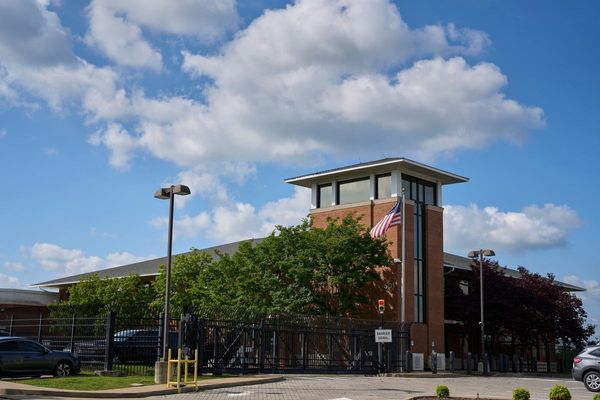
This winter, storm after storm after storm dumped rain and snow on California, and now, as the spring poppies bloom, the state is lush. Hillsides once prickly with dry vegetation have softened. Ski resorts, once thawed out and closed by late spring, are buried under record snow and planning to stay open into July. Satellite photos show a state transformed from brown to green, streaked from top to bottom with bright-emerald patches.
The onslaught of water brought problems, such as deadly snowstorms and floods. But now that it’s stopped, the state’s residents seem to be finally getting a break after years of constant climate emergencies. For the first time in three years, the majority of the state is not in drought. And the storms have likely delayed the start of wildfire season by weeks, if not months.
Right now a lot of California really is in a climate lull. But it won’t last. In the near term, more floods are coming. In the long term, this period of excessive moisture might even lead to a worse wildfire season later this year or some year down the line. And the state’s next drought is always lingering just around the corner.
Although parts of the state are set to enjoy a luscious spring, communities in the Central Valley are still struggling with too much water. A “phantom lake” has reappeared, and locals fear it may spill over the levee in the city of Corcoran, home to more than 20,000 people. The rain may have paused, but there’s still more water to come: At some point, all of that extra snow currently sitting on mountaintops will melt and flow downhill into the already flood-strained region. If it melts too fast, it could cause additional flooding.
The water surplus might also have a counterintuitive intensifying effect on wildfires. True, it has very likely pushed back the start of wildfire season, which typically begins as early as May. The rain and snow have laid down a kind of protective moisture blanket over the state. Stuff is wet, and all of this moisture makes it harder for the land to burn at the vicious rate it does in dry years. Moreover, the deep snowpack will help keep things damp, particularly in areas closer to the mountains. “It’s likely that the traditional start of the season will be offset by several weeks to a month or two across a lot of locations, particularly the higher-elevation locations,” Jonathan O’Brien, a meteorologist with the National Interagency Fire Center’s Predictive Services, told me.
But in the long term, all of this vegetation might be a problem. Plants, both living and dead, are fuel, so a productive spring growth could bring trouble when the heat hits and things dry out. Lower-lying grassy areas are particularly at risk. Research has shown that “some of our biggest wildfire years have been drought years that’ve followed really good rainfall years,” Leslie Roche, a professor at UC Davis in the plant-sciences department, told me. “If we go from a really, really good year to a really, really extreme drought year again, the risks there are magnified.”
California just can’t catch a break. Part of the problem is its unique boom-bust climatology: The state always seems to go big, and that includes its weather cycles. “When it’s dry, it’s really dry. When it’s wet, it’s really wet,” Faith Kearns, a researcher at the California Institute for Water Resources, told me. (This variability has to do with the jet stream, the position of which affects both the number of winter storms that hit California and their size.) Changes to the planet’s climate are supercharging this ping-pong effect, creating what researchers call “climate whiplash.”
“That’s the thing about climate change,” Roche said. “It makes our typical extremes that much more extreme.” Just a few months ago, in November, about 90 percent of California was under severe drought or worse, according to the U.S. Drought Monitor. Now the rain is filling up reservoirs shockingly quickly. Governor Gavin Newsom has loosened drought restrictions.
It’s a dramatic turnaround even by California standards. The past three years marked the state’s three driest years on record, surpassing a dry spell that lasted from 2013 to 2015. The entirety of the state—every single county—had been in some form of a drought since spring 2020. “The drought that we had was so, so severe and so deeply entrenched that typically, even if things go well, even if you do start to get precipitation, it takes a long time—months and often years—to dig out of a drought like that,” O’Brien said. “And we really did it in three months.”
Perhaps the speed with which this reprieve arrived is a sign that it isn’t destined to last. But that doesn’t mean you shouldn’t get out and enjoy it anyway. “We can start to feel like we always have to be upset about climate change,” Kearns told me. “I think it’s still worth going [out] and letting your eyes soak in all the green and all the snow and all of that, while also kind of understanding that there still are these challenges for managing even too much water in California.”
The state’s water infrastructure isn’t designed to handle the climate whiplash, Ted Grantham, a professor who studies water management at UC Berkeley, told me: “We really need to start making decisions and investments in adapting to this new normal.” Because the next disaster will come. This year, next year, or later, there will be floods. There will be wildfires. There will be another drought. Living in California means having to prepare for all of those threats, sometimes in quick succession.







